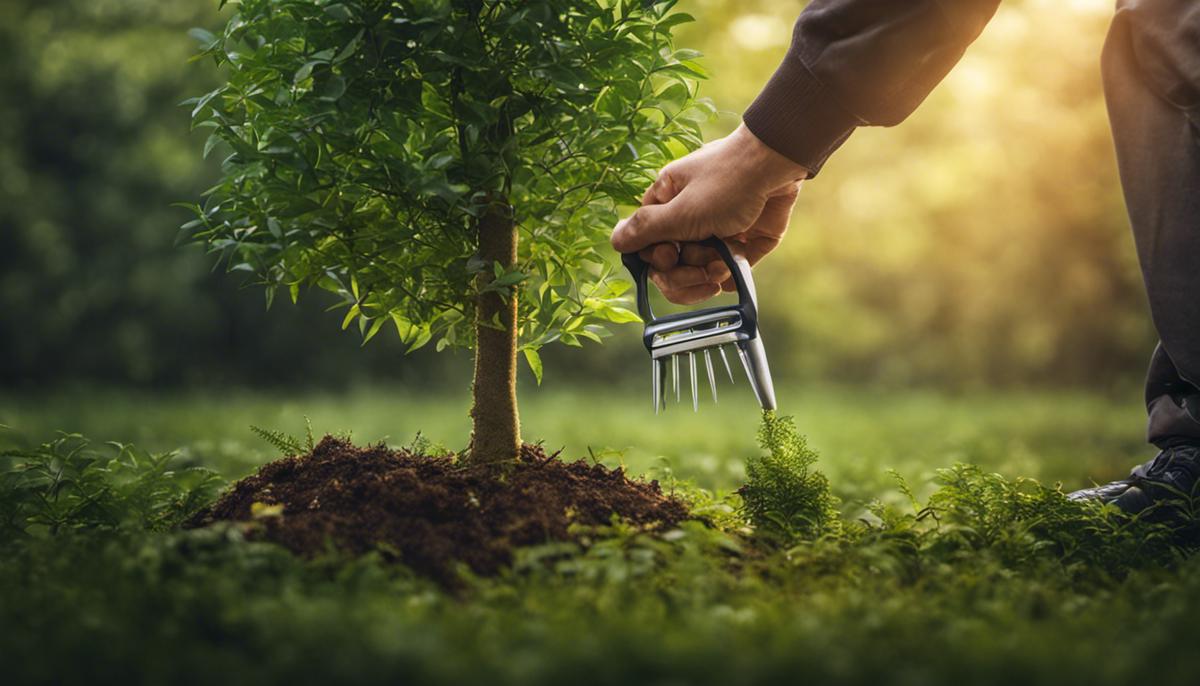Grow Your Garden: Planting a Tree from a Branch

In the vast expanse of our flourishing environment, trees play an essential role in fostering a sustainable ecosystem. Nonetheless, the art of propagating trees from branches is a skill that isn’t widespread. A branch’s successful transformation into a tree calls for a solid understanding of several critical elements. The central focus of this dialogue will revolve around highlighting the integral steps in the process—from selecting a perfect, disease-free branch to nurturing it into a full-fledged tree. The intention is to offer a comprehensive guide on proper timing for cuttings, the right size selection, sterilized cutting methods, and how to prepare your chosen branch for planting.
Selection and Preparation of Tree Branch
Brace yourselves, horticulture enthusiasts!
Here’s the ultimate guide to select and prepare a tree branch for planting. Whether you’re an experienced gardener or just beginning your journey in the world of tree propagation, this thorough yet straightforward guide will navigate you through the entire process.
First things first
When it comes to selecting the perfect branch, there are a few aspects one needs to consider. The branch should be healthily green, ideally from a tree that’s thriving. It’s not just aesthetics that matter, but also the time of the year. Late winter or early spring, before the buds have had a chance to open, is the best time for us to harvest these branches.
Wondering what to do after identifying the perfect branch? The answer is pruning. Pruning is cutting off a section of the branch that’s at least 6-8 inches long, and has several nodes (swollen areas where leaves emerge). The cut needs to be done on an angle and just below a node because that’s where the highest concentration of potential rooting hormones lie. Insist on using a sharp, sterile pruning shears as it prevents infections and promotes a cleaner cut that heals more effectively.
Next on the agenda is prepping the pruned branch for planting.
This involves applying a rooting hormone which increases the likelihood of root initiation. Various commercial options are available but creating a homemade blend can also be a fun journey in the quest for propagation.
After coating the base of the branch with rooting hormone, it’s planting time. A growing medium composed of equal parts peat and Perlite is highly recommended due to its excellent drainage properties. It creates a perfect environment for the new roots to grow and establish themselves. Simply make a hole in the growing medium, insert the hormone-coated branch base, and ensure it’s standing upright.
Then comes the all-important step of ensuring the perfect humidity for the new plant. For this purpose, use a plastic bag or a recycled plastic bottle, making a mini-greenhouse over the plant. This technique helps maintain the right level of humidity, without which the branch may dry up and die before it even gets a chance to root.
Post the prep, it’s all about patience. In approximately three to six weeks, carefully tug at the branch. If it offers resistance, it is a sign that roots have started to form. It’s quite a thrilling moment to witness the birth of a new tree, a testament to persistence and patience.
Well, that’s all for now, fellow horticulture enthusiasts! Remember, the world of tree propagation might have its challenges, but a little patience and a lot of love can see us through. Here’s to countless more green friends in our homes and gardens!

Rooting Tree Branches
Once the fundamentals of rooting a tree branch are solidly understood and adeptly executed, the journey towards branching-by-branch population of your backyard Eden is crosses a certain cusp. It’s akin to unlocking a new tier in the game of gardening where one can bring forth an entire generation of trees identical to the original. After all, the beauty of propagation is in the details, perfectly pitched to titillate the dendrophile in all of us.
Post selection and cut of the branch, let’s now delve into the next chapter – planting the branch with verve and precision. Good soil is pivotal to the survival of the newly planted stem. The preferred soil for this purpose should be lightweight, well-draining and fortified with organic matter. A mixture of sand, peat moss, and perlite serves as the ideal concoction.
Now, it’s showtime! Making a hole in the soil set the stage for planting the treated branch. The hole’s depth should roughly be double the length of the branch’s buried part covered by the rooting hormone. This prevents the hormone from alluring unwanted guests such as fungi and bacteria.
Having planted the stem, water the soil generously till it’s evenly moist. This initiates the root development process. Thereafter, maintain the moisture by watering lightly but regularly. A dry spell can be fatal, turning a promising propagation attempt into a mere twig.
Lighting plays a significant role too. All plants need light to photosynthesize and grow, but tender cuttings need it in a perfectly balanced amount. They enjoy bright but indirect light. Harsh direct sunlight can cause them to lose water quickly and wilt, so that cozy corner by your window could be the ideal haven for your new rooting.
Now comes the moment of reckoning – the birth of new roots. This is the time for a jubilant celebration as your efforts come to fruition. You can confirm this new growth by gently tugging at the plant. If you feel resistance, you know the roots have made their home in the soil and are growing.
It’s essential to remember that the balance between light, water, and temperature is crucial at this stage. Extra vigilance over these aspects can ensure a strong and healthy root system. Avoid temptation to yank out the stem to check progress visually. Patience, as always, harmonizes the symphony of successful propagation.
When you see a robust new shoot erupting, it’s time to introduce the fledgling to the real world. Start by gradually reducing the humidity in their environment over several days. Once they are sun-ready, plant them outdoors, preferably during spring or early fall.
Rooting a tree branch can be a thrilling experience. It creates a sense of accomplishment and puts you in sync with nature. Remember, it’s both an art and a science, requiring meticulous observation and timely decisions. We hope these detailed steps help you root a tree branch more confidently, taking you one step closer to your gardening goals. Be the maestro of your establishment in green. Let propagation be your purpose and patience be your guide, and each rooted branch your badge of achievement.

Caring for the New Plant
Ahh, you’ve successfully rooted that tree branch. Excellent work, my fellow green thumb! But don’t put the gardening gloves away quite yet. There’s another essential part to this horticultural symphony – caring for the newly planted tree.
First things, first — you’ll need to select a permanent spot for your young tree. This decision isn’t to be made lightly. Its location plays a significant role in its growth and well-being. The tree should be situated where it’ll receive at least six hours of sunlight each day. Nevertheless, the intensity of direct sunlight exposure can be determined better by the type of tree.
Once you’ve chosen the tree’s new abode, it’s time to move it from its nursery pot. Dig a hole that’s roughly twice the width of the pot, and just about as deep. This roominess eases root expansion and prevents the root ball from sinking too deep, which might waterlog it.
With your tree snugly nestled in its new hole, backfill the hole with the original soil you excavally dug out. Don’t add compost or fertilizers. Why? Well, preparing too cushy of a spot could discourage the roots from venturing beyond the snug little nutrient-fest you’ve created for them. Hence, disturb the soil as little as possible to encourage roots to establish in the native soil.
Watering, obviously, is essential, but frequency depends on your tree’s species and your local climate. Generally, a good, deep soak once a week is sufficient. A long, slow trickle from a garden hose works like a charm. However, during hotter periods, you may need to water more frequently. Remember that more trees die from overwatering than underwatering, so maintain a good balance.
Now comes a crucial step — tree staking. Newly planted trees can be top-heavy or have underdeveloped root systems. To offer the little fella some support through high winds or rainstorms, employing stakes and soft tying materials will do the trick. Only stake the tree if necessary, and don’t forget to remove the supports after its first year in the ground.
Next, mulching is like the cherry topping to your effort. It helps retain moisture, suppress weeds, and moderate soil temperature. Lay a 2-3 inch layer of mulch around the base of the tree but make sure it doesn’t touch the trunk. This ‘doughnut’ style assures that the bark doesn’t rot or harbors critters.
Lastly, it’s important to protect the trunk, especially if you live in regions where sunscald is a problem or where rodents or other animals may damage the bark. You can wrap the trunk with a commercial tree wrap or use a plastic guard.
Alright, now kick back and watch the lovely creation of nature progress right before your eyes. Understand, these trees are total champs. They’ll surprise you with their resilience and tenacity. It’s time to enjoy this rewarding journey and nurture your eco-friendly footprint. This is not only a hobby but a sublime contribution to our planet. Welcome to the club!

Planting a tree from a branch transcends mere routine—it should be viewed as an investment into the ecosystem and for posterity. The knowledge about promoting root growth, creating a supporting environment with the correct humidity and temperature, watering the budding plant, shielding it from harsh environmental conditions, and suitably nourishing it with measured fertilization are all pivotal aspects that build towards successful tree growth. The journey from a branch to a tree is a profound one, and the knowledge shared herein will hopefully empower you to partake in this gratifying journey, thus contributing to creating a healthier, greener world.



